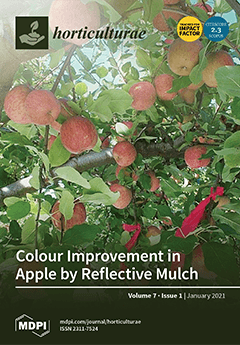The development of fruit ripening of ‘Valencia’ orange trees [
Citrus sinensis (L.) Osb.] grafted on the following ‘Trifoliata’ hybrid rootstocks: ‘US-852’, IPEACS-256 and IPEACS-264 citrandarins, and F.80-3, ‘W-2’ citrumelo, and ‘Swingle’ citrumelo (control), was assessed in three different subtropical locations: Rancho Alegre
[...] Read more.
The development of fruit ripening of ‘Valencia’ orange trees [
Citrus sinensis (L.) Osb.] grafted on the following ‘Trifoliata’ hybrid rootstocks: ‘US-852’, IPEACS-256 and IPEACS-264 citrandarins, and F.80-3, ‘W-2’ citrumelo, and ‘Swingle’ citrumelo (control), was assessed in three different subtropical locations: Rancho Alegre (RA); São Sebastião da Amoreira (SSA); and São Jerônimo da Serra (SJS), Parana state, Brazil. The climate of the RA and SSA locations was classified as Cfa with hot summers, whereas that of the SJS location was Cfb with temperate summers, which are located at 380, 650, and 835 m a.s.l., respectively. A completely randomized block design with four replications and four trees per plot was used as a statistical model for each location. The soluble solids (SS) content, titratable acidity (TA), and the maturation index (MI) or
ratio (SS/TA) of the juice, as well as the citrus color index (CCI) of fruit skin, were assessed monthly, beginning 200 days after flowering until harvest, totaling seven sampling dates. The data sets of each location were analyzed independently through a two-way analysis of variance (ANOVA) involving rootstocks in a split plot array in time (days) to allow for the assessment of the significance of the main effects, complemented by regression analysis. In general, the ripening of ‘Valencia’ orange fruits was influenced by the different ‘Trifoliata’ hybrid rootstocks. At the RA location, trees on IPEACS-256 and’ US-852’ citrandarins had the highest SS, and on ‘US-852’ citrandarin had the highest MI, reaching the MI
im earlier than the other rootstocks. The highest CCI was achieved when trees were on IPEACS-256 citrandarin. At the SSA location, trees on ‘US-852’, IPEACS-256, and IPEACS-264 citrandarins had the highest SS, but on ‘US–852’ had the highest MI, reaching the earliest MI
im among the rootstocks. The highest CCI was achieved when trees were on ‘US-852’ and IPEACS-256 citrandarins. In the SSJ location, there was no significant effect of the rootstocks on and of the variables of ‘Valencia’ orange fruit. This assessment can be useful in the planning of new orchards producing high-quality fruit with desirable features for the orange juice industry.
Full article





